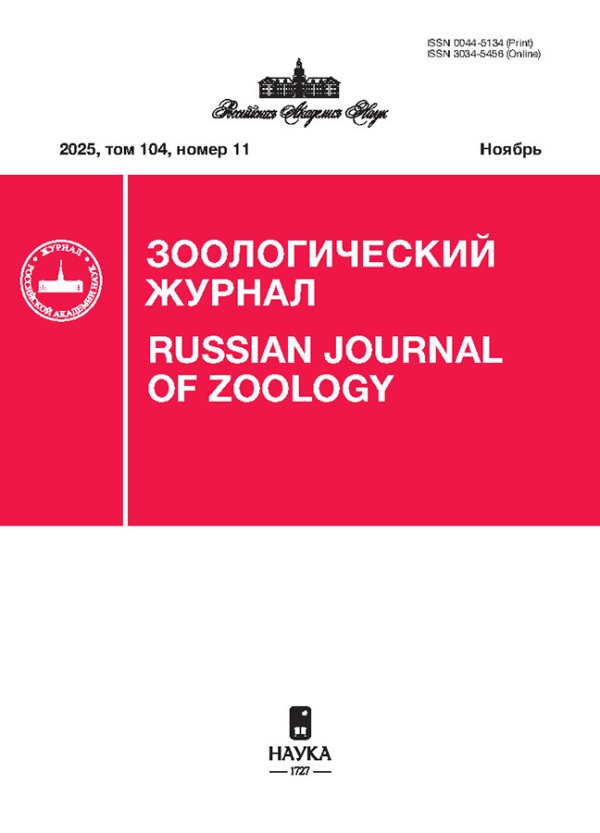Vol 102, No 5 (2023)
ARTICLES
Two new species of Anderemaeus (Acari, Oribatida, Anderemaeidae) from Peru
Abstract
The oribatid mite genus Anderemaeus (Oribatida, Anderemaeidae) is recorded from Peru for the first time. Two new species of this genus, A. friedrichi sp. n. and A. paracapitatus sp. n., are described based on material collected from soil and litter in Andean mountain forests.
 529-535
529-535


MORPHOLOGY OF THE DECAPODITE STAGES OF ARGIS LAR (OWEN 1839) (CARIDEA, CRANGONIDAE) FROM THE KRONOTSKY BAY, EASTERN KAMCHATKA
Abstract
Two decapodite stages of the shrimp, Argis lar, family Crangonidae, from the plankton off the Kronotsky Bay, northwestern Pacific, eastern Kamchatka, are described. Сomparison of The available larvae were morphologically compared with decapodites of other species of this family with a shortened development. The first and second decapodite stages were similar in size and structural features of the pleon, carapace, antennae, mandibles, maxillae, pereiopods, and pleopods. Significant differences were found in the morphology of the telson, maxilliped, and antennules in the first and second decapodite stages of A. lar. In the second decapodite stage, the posterior median spine shifted to the middle of the carapace, the number of antennular and maxilliped endopod segments were increased, the epipodite appeared in the third maxilliped, the shape of the telson changed, the terminal spines in the telson disappeared, and the relative length of the angular setae were decreased. Kuro shrimps are thought to have three to five larval stages.
 536-546
536-546


TWO NEW SPECIES OF BRISTLETAILS OF THE FAMILY MACHILIDAE (MICROCORYPHIA) FROM THE ALTAI MOUNTAINS
Abstract
Two new species of the bristletail family Machilidae are described: Ditrigoniophthalmus ongudaensis sp. n. and Allopsontus altaicus sp. n. The former, D. ongudaensis sp. n., differs from the known species of the genus Ditrigoniophthalmus Kaplin 1979 by the club-shaped paired ocelli, the relative lengths of the abdominal styli and urocoxites VIII and IX, and the basal and terminal portions of the penis in the male. Allopsontus altaicus sp. n. belongs to the subgenus Anisopsontus Mendes 1990 and is especially similar to the following four consubgeners: A. ciliatus (Wygodzinsky 1970), A. tekelensis Kaplin 2015, A. lineatus Kaplin 2002 and A. zinchenkoi Kaplin 2019. Yet, A. altaicus sp. n. differs in the number of articles of the ovipositor, the number of digging spines on its anterior and posterior gonapophyses, the number of rosette-shaped sensilla on the anterior femora of the male, the width to length ratios of paired ocelli in both sexes, the length to width ratios of the last article of the labial palps.
 547-560
547-560


FIRST DATA ON THE DYTISCIDAE (COLEOPTERA) FROM THE COASTAL TUNDRA OF YUGORSKY PENINSULA, POLAR RUSSIA
Abstract
In July 2018, diving beetles were collected in the most typical water bodies and other habitats in the vicinity of Amderma, Kara Sea coast, northern Yugorsky Peninsula. The fauna comprises 15 dytiscid species from 7 genera. The most diverse genera were Agabus and Hydroporus. The record of Dytiscus lapponicus was the northernmost for this species, while the reports of Hydroporus cf. fuscipennis and Agabus pallens were the northernmost for the Palaearctic parts of their distribution ranges. Original photographs illustrate peculiar specimens of Dytiscus lapponicus with dark head, pronotum and scutellum. Most of the species show vast Holarctic Arcto-Boreal or Arcto-Boreal-Montane distributions. The species composition of the Dytiscidae is quite similar to those of the northernmost mainland regions of the European Northeast (Pakhancheskaya Bay, Kara Tundra and Pamal), as well as the Vaigatch and Dolgyi islands, being less similar to those of the south tundra regions (Kanin Peninsula, Bolvanskaya Bay and Antipayuta village, Gydan Peninsula). Among the study habitats, the most diverse beetle assemblage inhabited thermokarst lakes (up to 14 species, the maximum density noted was 1150 ind./100 trap-days). On the contrary, on salt marshes, only 2–3 beetle species were recorded and the total abundance was significantly lower (1.8–3.6 ind./100 trap-days).
 561-571
561-571


DESTRUCTION OF GUILLEMOT COLONIES IN THE SOUTHERN BARENTS SEA AND THE FACTORS THAT DETERMINE IT
Abstract
Features of Common guillemot (Uria aalge) and Brünnich’s guillemot (U. lomvia) numbers dynamics have been analyzed based on long-term monitoring data obtained from colonies from the southern Barents Sea coast. Since the 2000s, the numbers of guillemots in colonies have been shown to gradually decrease. In 2019–2021, most of the guillemot colonies of the southern Barents Sea coast disappeared. Two factors have been found to affect the guillemot colonies’ dynamics in the last decades: fishing industry and change in oceanographic conditions. These two factors indirectly influence the guillemot populations in the winter-spring area, changing the availability of the birds’ food resources. The former affects only the birds from southwestern Barents Sea colonies, but the second is relevant within the whole winter-spring area from the Barents Sea to the western areas of the North Atlantic. They affect the guillemots’ living conditions in the most critical periods of their life. In future this may cause significant changes in the location of guillemot colonies in the southern Barents Sea.
 572-580
572-580


NEW DATA ON THE NORTHERN RANGE LIMIT AND CHROMOSOMAL SET OF THE USSURI WHITE TOOTHED SHREW (CROCIDURA LASIURA, SORICIDAE, LIPOTYPHLA)
Abstract
In an intermontane kettle at the southwestern spurs of the Bureinsky Mountain Range, in the Bureya River basin, the Ussuri white-toothed shrew has been recorded for the first time. This locality lies north of the previously supposed species distribution range in the south of the Russian Far East. The study of the female karyotype has allowed us to describe the morphology of the chromosomes of Crocidura lasiura (2n = 40, NF = 54). The karyotype differs from the earlier published information (2n = 40, NF = 56) on the number of subtelocentric autosomes. The data obtained expand the northern range limit of the Ussuri white-toothed shrew and show variability in the number of chromosome arms (NFа = 50, 52).
 581-586
581-586


INCREASE IN THE ABUNDANCE OF THE AMUR LEOPARD CAT (PRIONAILURUS BENGALENSIS EUPTILURA, FELIDAE, CARNIVORA) IN THE SOUTHERN AMUR REGION
Abstract
The Amur leopard cat (Prionailurus bengalensis euptilura Elliot 1871) in the south of the Russian Far East mainly lives in flat and foothill landscapes, which have now been mostly transformed by man. The data were collected in 1987–2022 in the southern Amur region (the left bank of the Amur River in the south of the Jewish Autonomous Oblast (JAO) and the right bank of the Amur River (the right bank of the estuary of the Ussuri River), Khabarovsk Krai). Traces of cats and dead animals were recorded, and camera traps were used. The data of 4560 diaries of employees of the Department of protection of the Bolshekhekhtsirsky Reserve, located in the research area, for 1964–2009 were used. Now on the left bank of the Amur River in the south of the JAO, the Amur leopard cat lives constantly, although in the 2010s it was believed that it rarely enters this territory. Number of sightings of cat tracks in the study area on the right bank of the Amur in 2011–2021 compared to the period 2000–2010 increased about two times. It has populated areas within the range where it has never been noted. The increase in the number and the process of settlement of the Amur leopard cat, both on the left bank and on the right bank of the Amur River began in the 2000s, and since the beginning of the 2010s it has been observed constantly. Currently, the cat lives sedentary in the southern Amur region, which is confirmed by the findings of its broods. The cat mainly lives on agricultural land, which is due to its ability to adapt well to anthropogenic changes in the habitat.
 587-601
587-601


GEOGRAPHIC VARIATIONS IN THE SHAPE OF THE UPPER TOOTHROW OF THE ARTCIC FOX (VULPES LAGOPUS L. 1758): EFFECTS OF ASYMMETRY AND ALLOMETRY
Abstract
Geographic variations in the shape of the upper cheek toothrow were studied using geometric morphometrics. For this, 288 specimens from 19 localities (North America, Eurasia, and Pacific and Arctic islands) were employed. Monomorphism of the toothrow for mainland foxes, both from North America and Eurasia, as well as the foxes from Greenland and St. Lawrence Island was found. The Arctic foxes of four Pacific island populations, i.e. two from the Commander Islands and two from the Pribilof Islands, differ significantly from the mainland counterparts in toothrow shape. The Arctic foxes from the Mednyi Island, the Bering Island and the Pribilof Islands differ from each other by toothrow shape as well. The Mednyi Island Arctic foxes show the shortest toothrow, a wide hard palate, and the most massive teeth. On the contrary, the Pribilof Islands Arctic foxes are the most small-toothed. Allometry does not affect geographic variations in the shape of the Arctic fox toothrow. High-level fluctuating asymmetry is found in the Mednyi Island and St. George Island Arctic foxes. Most probably the high level of fluctuating asymmetry is conditioned by both the extremely low genetic diversity as the result of a dramatic numbers decline in the recent past and the strong impact of heavy metals as the result of a coastal diet. We suppose that the same reasons. i.e. low genetic diversity and coastal diet, could have determined the high level of fluctuating asymmetry of the Arctic fox toothrow on the St. George Island.
 602-616
602-616


ЮБИЛЕЙ
REMEMBERING THE SCIENTIFIC ADVISOR (TOWARDS THE 110TH BIRTHDAY OF IGOR MIKHAILOVICH GROMOV)
 617-620
617-620












